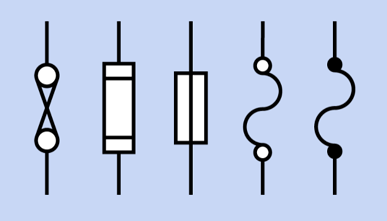Fuse
This article was generated with the help of Chat GPT!
Introduction and Purpose
Fuses are essential safety devices used to protect electrical circuits and devices from excessive current flow. They act as sacrificial elements that break the circuit when the current exceeds a predetermined value, preventing damage to sensitive components and minimizing the risk of electrical fires.
How does Fuse Work?
Fuses are designed with a thin strip of conductive material, usually made of copper or another alloy, placed inside a protective casing. When the current passing through the fuse surpasses its rated capacity, the heat generated by the excess current causes the fuse strip to melt and break the circuit, disconnecting the power supply.
Fuse Symbol

Fuse Symbol
Types of Fuse
-
Cartridge Fuses: Cylindrical fuses designed for higher voltage and current applications, commonly used in industrial settings and electrical distribution panels.
-
Blade Fuses: Rectangular-shaped fuses widely used in automotive applications and consumer electronics.
-
Resettable Fuses (PTCs): Also known as polymeric positive temperature coefficient (PTC) fuses, these fuses can automatically reset after cooling down, making them suitable for protecting electronic circuits against temporary overloads.
-
Thermal Fuses: Non-resettable fuses that use a heat-sensitive element to disconnect the circuit when a specific temperature is exceeded, commonly used in appliances and heating systems.
Fuses are critical safety components in electrical systems, ensuring the reliable and secure operation of various devices and preventing potential hazards caused by overcurrent situations.